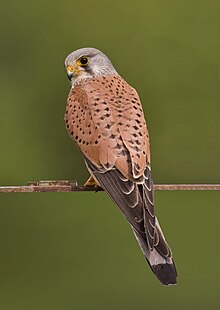Eufalconimorphae: Difference between revisions
Appearance
Content deleted Content added
Corrected 'cacaras' to 'caracaras'. |
Removed link from scientific name, ‘Falco tinnunculus’ and added link to common name, ‘Common kestrel’ |
||
| Line 2: | Line 2: | ||
| fossil_range = [[Paleocene]] - [[Holocene]], |
| fossil_range = [[Paleocene]] - [[Holocene]], |
||
| image = Common kestrel falco tinnunculus.jpg |
| image = Common kestrel falco tinnunculus.jpg |
||
| image_caption = Common kestrel, '' |
| image_caption = [[Common kestrel]], ''Falco tinnunculus'' |
||
| authority = Suh ''et al.'', 2011 |
| authority = Suh ''et al.'', 2011 |
||
| subdivision_ranks = Subclades |
| subdivision_ranks = Subclades |
||
Revision as of 21:23, 14 May 2016
| Eufalconimorphae | |
|---|---|

| |
| Common kestrel, Falco tinnunculus | |
| Scientific classification | |
| Domain: | Eukaryota |
| Kingdom: | Animalia |
| Phylum: | Chordata |
| Class: | Aves |
| Clade: | Australaves |
| Clade: | Eufalconimorphae Suh et al., 2011 |
| Subclades | |
Eufalconimorphae is a proposed clade of birds, consisting of passerines, parrots, falcons, caracaras and forest falcons, (but not other raptors).[1] It has whole-genome DNA support.[2]
References
- ^ Alexander Suh, Martin Paus, Martin Kiefmann, Gennady Churakov, Franziska Anni Franke, Jürgen Brosius, Jan Ole Kriegs & Jürgen Schmitz (2011). "Mesozoic retroposons reveal parrots as the closest living relatives of passerine birds". Nature Communications. 2 (8): 443. doi:10.1038/ncomms1448. PMC 3265382. PMID 21863010.
{{cite journal}}: CS1 maint: multiple names: authors list (link) - ^ Jarvis, E. D.; Mirarab, S.; Aberer, A. J.; Li, B.; Houde, P.; Li, C.; Ho, S. Y. W.; Faircloth, B. C.; Nabholz, B.; Howard, J. T.; Suh, A.; Weber, C. C.; Da Fonseca, R. R.; Li, J.; Zhang, F.; Li, H.; Zhou, L.; Narula, N.; Liu, L.; Ganapathy, G.; Boussau, B.; Bayzid, M. S.; Zavidovych, V.; Subramanian, S.; Gabaldon, T.; Capella-Gutierrez, S.; Huerta-Cepas, J.; Rekepalli, B.; Munch, K.; et al. (2014). "Whole-genome analyses resolve early branches in the tree of life of modern birds" (PDF). Science. 346 (6215): 1320–1331. doi:10.1126/science.1253451. PMID 25504713.
External links
- Tetrapod Zoology, after Suh et al. (2011).
